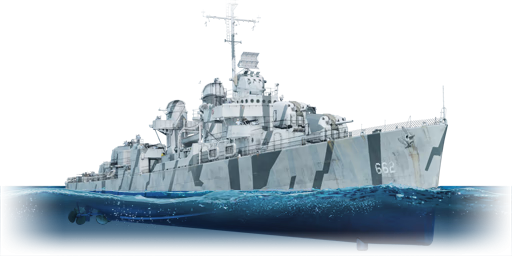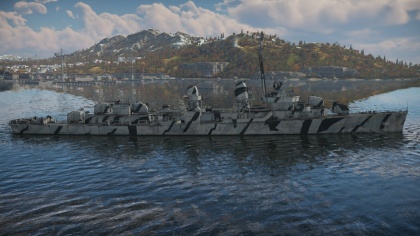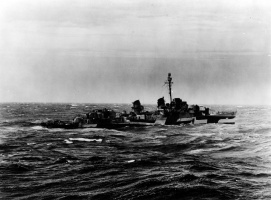Difference between revisions of "USS Bennion"
Inceptor57 (talk | contribs) m (→Description) |
Inceptor57 (talk | contribs) m (Fix referencing) |
||
| Line 237: | Line 237: | ||
[[File:HistoricImage USS Bennion (DD-662) underway.jpg|frameless|right|x200px]] | [[File:HistoricImage USS Bennion (DD-662) underway.jpg|frameless|right|x200px]] | ||
| − | The Fletcher-class destroyers were conceived as a 2,100 ton class destroyer following the underwhelming construction of the Benson and Gleaves-class destroyers that could not equip a total of five 5-inch guns and ten torpedoes. The design was approved in 27 January 1940 by the Secretary of the Navy, Charles Edison, with construction plans expanded after the Battle of France in Europe when Congress passed the Two-Ocean Navy Act on July 19th, allowing for the construction of 115 destroyers. The Fletcher-class destroyers began construction in October 1941, with eleven shipyards involved in their production.<ref name="McCombUSADestroyers"/> | + | The Fletcher-class destroyers were conceived as a 2,100 ton class destroyer following the underwhelming construction of the Benson and Gleaves-class destroyers that could not equip a total of five 5-inch guns and ten torpedoes. The design was approved in 27 January 1940 by the Secretary of the Navy, Charles Edison, with construction plans expanded after the Battle of France in Europe when Congress passed the Two-Ocean Navy Act on July 19th, allowing for the construction of 115 destroyers. The Fletcher-class destroyers began construction in October 1941, with eleven shipyards involved in their production.<ref name="McCombUSADestroyers">McComb, Dave, and Paul Wright. ''US Destroyers, 1942-45: Wartime Classes''. Osprey Publishing Ltd., 2010.</ref> |
| − | The '''USS Bennion''' was first laid down on 19 March 1943 at the Boston Navy Yard, named after Captain Mervyn S. Bennion, who was killed during the Japanese Pearl Harbor attack on 07 December 1941.<ref name="NavSourceBennion"/> The destroyer, christened by Bennion's widow, was launched on 04 July 1943, and following sea trials was commissioned into service on 14 December 1943 with Joshua W. Cooper in command.<ref name="BennionHisCentral"/> The USS Bennion was put into service in Destroyer Squadron 56 in Destroyer Division 111.<ref name="McCombUSADestroyers"/> | + | The '''USS Bennion''' was first laid down on 19 March 1943 at the Boston Navy Yard, named after Captain Mervyn S. Bennion, who was killed during the Japanese Pearl Harbor attack on 07 December 1941.<ref name="NavSourceBennion">Willshaw, Fred. "USS BENNION (DD-662)." NavSource Naval History, [https://www.navsource.org/archives/05/662.htm Website].</ref> The destroyer, christened by Bennion's widow, was launched on 04 July 1943, and following sea trials was commissioned into service on 14 December 1943 with Joshua W. Cooper in command.<ref name="BennionHisCentral">History Central. "USS Bennion DD 662." History Central, 1999, [https://www.historycentral.com/navy/destroyer/Benniondd662.html Website].</ref> The USS Bennion was put into service in Destroyer Squadron 56 in Destroyer Division 111.<ref name="McCombUSADestroyers"/> |
| − | USS Bennion left for the Pacific on 03 March 1944, conducting training around Pearl Harbor until May 29th. From then, the USS Bennion joined the Pacific War as as a fighter director and radar picket ship and saw action at Saipan, Tinian, Guam, Peliliu, Philippines, Leyte Gulf, Iwo Jima, and Okinawa.<ref name="BennionHisCentral"/> At Leyte Gulf, the USS Bennion was involved in the Battle of Surigao Strait, where it assisted with the sinking of the Japanese battleship Yamashiro.<ref name="BennionSurigao"/> For the USS Bennion's actions off of Okinawa, the destroyer received eight battle stars and a presidential unit citation.<ref name="BennionHisCentral"/><ref name="BennionCitation"/> | + | USS Bennion left for the Pacific on 03 March 1944, conducting training around Pearl Harbor until May 29th. From then, the USS Bennion joined the Pacific War as as a fighter director and radar picket ship and saw action at Saipan, Tinian, Guam, Peliliu, Philippines, Leyte Gulf, Iwo Jima, and Okinawa.<ref name="BennionHisCentral"/> At Leyte Gulf, the USS Bennion was involved in the Battle of Surigao Strait, where it assisted with the sinking of the Japanese battleship Yamashiro.<ref name="BennionSurigao">Holloway, James L. "Second Salvo at Surigao Strait." U.S. Naval Institute, Oct. 2010, [https://www.usni.org/magazines/naval-history-magazine/2010/october/second-salvo-surigao-strait Website].</ref> For the USS Bennion's actions off of Okinawa, the destroyer received eight battle stars and a presidential unit citation.<ref name="BennionHisCentral"/><ref name="BennionCitation">Parkinson, Bill. "USS Bennion DD 662 Presidential Unit Citation." Destroyer History Foundation, [http://destroyerhistory.org/fletcherclass/ussbennion_puc/ Website].</ref> |
After the war, the USS Bennion was sent to the Puget Sound Navy Yard on 21 October 1945 before being decommissioned on 20 June 1946 and became part of the reserve fleet. USS Bennion was stricken from the register on 15 April 1971 and was sold in 30 May 1973 and broken up for scrap.<ref name="BennionHisCentral"/> | After the war, the USS Bennion was sent to the Puget Sound Navy Yard on 21 October 1945 before being decommissioned on 20 June 1946 and became part of the reserve fleet. USS Bennion was stricken from the register on 15 April 1971 and was sold in 30 May 1973 and broken up for scrap.<ref name="BennionHisCentral"/> | ||
| Line 265: | Line 265: | ||
{{USA destroyers}} | {{USA destroyers}} | ||
{{USA premium ships}} | {{USA premium ships}} | ||
| − | |||
| − | |||
| − | |||
| − | |||
| − | |||
| − | |||
Revision as of 19:45, 2 June 2019
Contents
Description
The Fletcher-class, USS Bennion (DD-662), 1944 is a gift Rank III American destroyer
with a battle rating of 4.7 (AB/RB/SB). It was introduced in Update 1.79 "Project X" as a Xbox One exclusive vehicle purchasable on the Microsoft Store.
As a Fletcher-class destroyer, the USS Bennion resembles its sister ships Fletcher and Cowell in terms of performance characteristics. The most distinctive differences the USS Bennion has compared to its sisters, specifically the C is its designation number of 662, and an unique dazzle camouflage following the MS-32/13D design pattern. Compared to its closer relative, the Cowell, the Bennion possess an extra 5,000 rounds of 40 mm Bofors ammunition.
General info
Survivability and armour
As part of the Fletcher-class family, the USS Bennion's armour profile are not so different from its sisters, with armour plates covering the individual 127 mm gun turrets and primarily hull protection at the sides and roof.
Armour type:
- Antifragmentation armour
- Cast homogeneous armour
- Hardened armour
| Armour | Bow (Slope angle) | Sides | Stern | Deck |
|---|---|---|---|---|
| Hull | N/A | 13 mm (0-24°) | N/A | 13 mm (85-89°) |
| Armour | Front | Sides | Rear | Roof |
| Turrets | 3.2 mm Front 15 mm Gun mantlet |
3.2 mm | 3.2 mm | 3.2 mm |
Notes:
- The fire-control radar atop the bridge is covered with an antifragmentation armour with 19 mm thickness.
- Gun shields around the 20 mm Oerlikon autocannons are 12.7 mm thick.
Mobility
| Mobility characteristic | ||
|---|---|---|
| Weight (tons) | ||
| 2,924 | ||
| Max Speed (km/h) | ||
| Mode | Stock | Upgraded |
| Arcade | 58 | 79 |
| Realistic/Simulator | 56 | 65 |
Armament
Primary armament
| 127 mm 5/38 Mark 12 Dual Purpose gun (x5) | ||||||
|---|---|---|---|---|---|---|
| Turrets (Bow to stern) | ||||||
| Turret 1 | Turret 2 | Turret 3 | Turret 4 | Turret 5 | ||
| Vertical guidance | -15°/+85° | |||||
| Horizontal guidance | ±150° | ±143° | ±150° | |||
| Ammo capacity | 1,800 | |||||
Ammunition
| Penetration statistics | |||||||
|---|---|---|---|---|---|---|---|
| Ammunition | Type of warhead |
Penetration in mm @ 0° Angle of Attack | |||||
| 1000m | 2500m | 5000m | 7500m | 10000m | 15000m | ||
| 127 mm AAC Mk.34 | HE | 54 | 49 | 40 | 36 | 36 | 36 |
| 127 mm Common Mk.32 | SAP | 125 | 100 | 70 | 50 | 38 | 25 |
| 127 mm AAVT Mk.31 | HE-VT | 54 | 49 | 40 | 36 | 36 | 36 |
| Shell details | ||||||||||
|---|---|---|---|---|---|---|---|---|---|---|
| Ammunition | Type of warhead |
Velocity in m/s |
Projectile Mass in kg |
Fuse delay
in m: |
Fuse sensitivity
in mm: |
Explosive Mass in g (TNT equivalent): |
Normalization At 30° from horizontal: |
Ricochet: | ||
| 0% | 50% | 100% | ||||||||
| 127 mm AAC Mk.34 | HE | 792 | 25 | 0.4 | 0.1 | 3,220 | +0° | 79° | 80° | 81° |
| 127 mm Common Mk.32 | SAP | 792 | 25 | 10 | 10 | 1,150 | -1° | 47° | 60° | 65° |
| 127 mm AAVT Mk.31 | HE-VT | 792 | 25 | 0.0 | 0.1 | 3,220 | +0° | 79° | 80° | 81° |
Secondary armament
| 40 mm Bofors Mk. I (x10) | ||||||
|---|---|---|---|---|---|---|
| Turrets (Bow to stern) | ||||||
| Front port turret (x2) | Front starboard turret (x2) | Middle port turret (x2) | Middle starboard turret (x2) | Rear turret (x2) | ||
| Vertical guidance | -15°/+88° | -10°/+88° | -15°/+88° | |||
| Horizontal guidance | -150°/+90° | -90°/+150° | -180°/+20° | -20°/+180° | ±180° | |
| Ammo capacity | 25,000 | |||||
Belts
| Belts | Shell composition | Combat usage |
| Universal | AP-T – HEF-T – AP-T – HEF-T | |
| 40 mm HE clips | HEF-T – HEF-T – HEF-T – AP-T | |
| 40 mm AP clips | AP-T – AP-T – AP-T – HEF-T |
Anti-aircraft armament
| 20 mm Oerlikon Mk.II (x7) | |||||||
|---|---|---|---|---|---|---|---|
| Turrets (Bow to stern) | |||||||
| Front port turret | Middle port turret | Front starboard turret | Middle starboard turret | Rear port turret | Rear starboard turret | Rear stern turret | |
| Vertical guidance | -80°/+65° | ±100° | -65°/+80° | ±100° | ±180° | ||
| Horizontal guidance | -4°/+50° | ||||||
| Ammo capacity | 16,800 | ||||||
Torpedo armament
| 533 mm steam turbined Mk.15 torpedo (x10) | ||||||||
|---|---|---|---|---|---|---|---|---|
| Mode | Mass (kg) | Maximum speed in water (km/h) |
Travel distance (km) | Depth stroke (m) | Arming distance (m) |
Explosive type | Explosive mass (kg) | |
| Stock | 1,559 | 83 | 5.50 | 1.0 | 50 | TNT | 224 | |
| Torpedo mode | 62 | 9.15 | ||||||
Special armament
- Without load
- 6 x Mk.6 mortar depth charge
Usage in battles
Describe the technique of using this ship, the characteristics of her use in a team and tips on strategy. Abstain from writing an entire guide – don’t try to provide a single point of view, but give the reader food for thought. Talk about the most dangerous opponents for this vehicle and provide recommendations on fighting them. If necessary, note the specifics of playing with this vehicle in various modes (AB, RB, SB).
Pros and cons
Pros:
- Dual-purpose 5-inch guns
- Access to proximity-fuze shells for anti-aircraft duties
Cons:
- More protected only against fragmentation and shrapnel than against shells
History
The Fletcher-class destroyers were conceived as a 2,100 ton class destroyer following the underwhelming construction of the Benson and Gleaves-class destroyers that could not equip a total of five 5-inch guns and ten torpedoes. The design was approved in 27 January 1940 by the Secretary of the Navy, Charles Edison, with construction plans expanded after the Battle of France in Europe when Congress passed the Two-Ocean Navy Act on July 19th, allowing for the construction of 115 destroyers. The Fletcher-class destroyers began construction in October 1941, with eleven shipyards involved in their production.[1]
The USS Bennion was first laid down on 19 March 1943 at the Boston Navy Yard, named after Captain Mervyn S. Bennion, who was killed during the Japanese Pearl Harbor attack on 07 December 1941.[2] The destroyer, christened by Bennion's widow, was launched on 04 July 1943, and following sea trials was commissioned into service on 14 December 1943 with Joshua W. Cooper in command.[3] The USS Bennion was put into service in Destroyer Squadron 56 in Destroyer Division 111.[1]
USS Bennion left for the Pacific on 03 March 1944, conducting training around Pearl Harbor until May 29th. From then, the USS Bennion joined the Pacific War as as a fighter director and radar picket ship and saw action at Saipan, Tinian, Guam, Peliliu, Philippines, Leyte Gulf, Iwo Jima, and Okinawa.[3] At Leyte Gulf, the USS Bennion was involved in the Battle of Surigao Strait, where it assisted with the sinking of the Japanese battleship Yamashiro.[4] For the USS Bennion's actions off of Okinawa, the destroyer received eight battle stars and a presidential unit citation.[3][5]
After the war, the USS Bennion was sent to the Puget Sound Navy Yard on 21 October 1945 before being decommissioned on 20 June 1946 and became part of the reserve fleet. USS Bennion was stricken from the register on 15 April 1971 and was sold in 30 May 1973 and broken up for scrap.[3]
Media
Excellent additions to the article would be video guides, screenshots from the game, and photos.
See also
- Fletcher (DD-445): Sister ship, the lead ship of the Fletcher-class
- Cowell (DD-547): Sister ship
External links
| USA destroyers | |
|---|---|
| Clemson-class | USS Welborn C. Wood · USS Barker · USS Litchfield |
| Farragut-class | USS Aylwin |
| Bagley-class | USS Bagley |
| Porter-class | USS Porter · USS Phelps · USS Moffett |
| Somers-class | USS Somers · USS Davis |
| Fletcher-class | USS Fletcher · USS Bennion · USS Cowell |
| Allen M. Sumner-class | USS Sumner |
| Gearing-class | USS Gearing · USS Frank Knox |
| Mitscher-class | USS Mitscher · USS Wilkinson |
| USA premium ships | |
|---|---|
| Motor torpedo boats | PT-3 · PT-109 · PT-174 · Thunderbolt (PT-556) · PT-658 · PT-811 |
| Motor gun boats | LCM(6) Zippo · USS Douglas · USS Flagstaff |
| Sub-chasers | Carmi (PC-466) |
| Destroyers | USS Welborn C. Wood · USS Wilkinson · USS Bennion · USS Cowell · USS Davis · USS Moffett · USS Phelps · USS Frank Knox |
| Light cruisers | USS Detroit · USS Helena |
| Heavy cruisers | USS Des Moines |
| Battleships | USS Arkansas |
- ↑ 1.0 1.1 McComb, Dave, and Paul Wright. US Destroyers, 1942-45: Wartime Classes. Osprey Publishing Ltd., 2010.
- ↑ 3.0 3.1 3.2 3.3 History Central. "USS Bennion DD 662." History Central, 1999, Website.
- ↑ Holloway, James L. "Second Salvo at Surigao Strait." U.S. Naval Institute, Oct. 2010, Website.
- ↑ Parkinson, Bill. "USS Bennion DD 662 Presidential Unit Citation." Destroyer History Foundation, Website.






